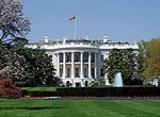
and principal workplace of the president of the United States
. Located at 1600 Pennsylvania Avenue
NW in Washington, D.C.
, the house was designed by Irish-born James Hoban
, and built between 1792 and 1800 of white-painted Aquia sandstone in the Neoclassical style
. It has been the residence of every U.S. president since John Adams
. When Thomas Jefferson
moved into the house in 1801, he (with architect Benjamin Henry Latrobe) expanded the building outward, creating two colonnade
s that were meant to conceal stables and storage.
In 1814, during the War of 1812
, the mansion was set ablaze by the British Army
in the Burning of Washington
, destroying the interior and charring much of the exterior.
1792 In Washington, D.C., the cornerstone of the United States Executive Mansion (known as the White House since 1818) is laid.
1800 U.S. President John Adams takes up residence in Washington, D.C. (in a tavern because the White House was not yet completed).
1800 US President John Adams becomes the first President of the United States to live in the Executive Mansion (later renamed the White House).
1814 British troops invade Washington, D.C. and burn down the White House and several other buildings.
1814 Washington, D.C. is burned and White House is destroyed by British forces during the War of 1812.
1841 U.S. President John Tyler vetoes a bill which called for the re-establishment of the Second Bank of the United States. Enraged Whig Party members riot outside the White House in the most violent demonstration on White House grounds in U.S. history.
1886 U.S. President Grover Cleveland marries Frances Folsom in the White House, becoming the only president to wed in the executive mansion.
1901 President Theodore Roosevelt officially renames the "Executive Mansion" to the White House.
1910 The English aviator Claude Grahame-White lands his Farman Aircraft biplane on Executive Avenue near the White House in Washington, D.C.
1917 Ten Suffragettes are arrested while picketing the White House.

